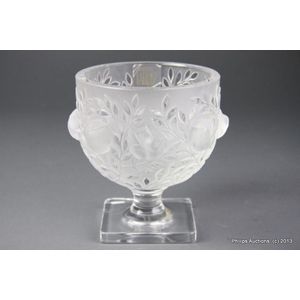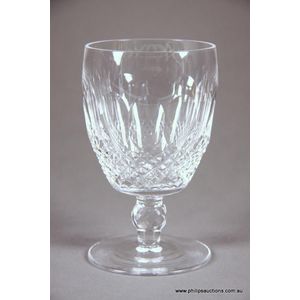Gilt-accented 18th century wine glass
You must be a subscriber, and be logged in to view price and dealer details.
Subscribe Now to view actual auction price for this item
When you subscribe, you have the option of setting the currency in which to display prices to $Au, $US, $NZ or Stg.
- Faceting - Faceting is a technique of removing material from a curved surface, to give a series of flat surfaces but retaining the profile of the original surface.
The technique is most commonly associated with diamond cutting where the various cuts used such as rose cut and brilliant cut, add life and sparkle to the stone, whilst at the same time removing as little of the stone as possible.
Faceting by grinding is also used to decorate glass. The stems of many drinking glasses are decorated by cutting a series of flat surfaces on a circular stem, and hollow vessels such as vases may have faceted surfaces.
In furniture faceting is often applied to legs of tables and chairs, where a circular baluster shaped section is flattened so as to form an octagonal section. - Knop - In Georgian glassware, the knop is a bulbous protrusion, usually midway up the stem of the glass. It may be included singly or in groups, and may be hollow or solid. There are many styles of knop including basal, baluster, bell, acorn, cone, flattened, melon and mushroom.
- Knop (glass) - In Georgian glassware, the knop is a bulbous protrusion, usually midway up the stem of the glass. It may be included singly or in groups, and may be hollow or solid. There are many styles of knop including basal, baluster, bell, acorn, cone, flattened, melon and mushroom.
- Bowl - With drinking glasses, the bowl is the hollow section of the glass that holds the liquid. Many glasses were mounted on a stem joined to a foot, others were cylindrical, of tumbler shape. The size and shape of the bowl was determined by the type of liquids they were meant to hold. Shapes used included bell shaped, conical (funnel), bucket shaped, trumpet, cup, ogee, funnel, cylindrical and rounded.
This item has been included into following indexes:
Visually similar items

A Lalique Elizabeth footed vase, circa 1950s, the frosted moulded bowl with a frieze of small songbirds in relief within leafy scrolled branches, upon a slender waisted stem to a square clear glass pedestal base; etched Lalique France to base and with orig

A pair of large clear etched glass wine rummers, French, 19th century. 24 cm high

A Lalique crystal Elizabeth pedestal vase, second half 20th century, pre-1978, engraved Lalique France mark, a frosted goblet with a frieze of eight small plump birds in high relief amidst stylised scrolling branches, with a short waisted stem to the clear

A fine set of twelve Waterford cut crystal 'Colleen' water glasses. Designed 1968, the lens and diamond cut glasses, with short knopped stems; stencil mark underside to all. Height 13 cm
